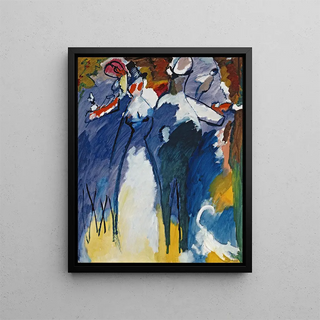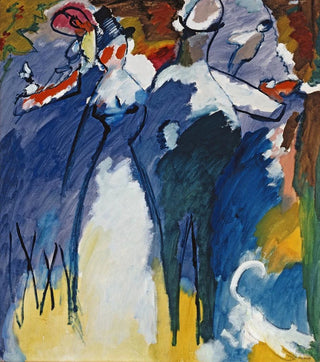Art print | Impression VI Sunday - Wassily Kandinsky


View from behind

Frame (optional)
Sunday Impression VI - Wassily Kandinsky – Captivating Introduction
In the vast panorama of art history, few works manage to capture the very essence of a movement like "Sunday Impression VI" by Wassily Kandinsky. This iconic creation, emerging from the depths of abstract expressionism, immerses us in a universe where colors and shapes intertwine to evoke profound emotions. The painted scene, vibrant with life, transports us to a moment of contemplation, where each brushstroke seems to vibrate with an almost tangible energy. With this art print, the viewer is invited to rediscover the intensity of a work that marked its era and continues to resonate in the hearts of art enthusiasts.
Style and uniqueness of the work
Kandinsky, a true pioneer of abstract art, transcended the conventions of his time. "Sunday Impression VI" stands out for its bold approach to color and composition. The bright hues, ranging from solar yellows to deep blues, intertwine harmoniously, creating an atmosphere that is both joyful and melancholic. Organic and geometric shapes blend into a visual ballet that defies figurative representation. This painting does not merely depict a scene; it invites the viewer to feel a unique sensory experience, to be carried away by a whirlwind of emotions. Kandinsky's technique, favoring spontaneous and intuitive gestures, reflects his desire to free art from traditional constraints, making each work an exploration of the human soul.
The artist and his influence
Wassily Kandinsky, born in 1866 in Russia, is often considered one of the founders of abstract art. His artistic career, marked by an incessant quest for new forms of expression, was deeply influenced by his studies in music and philosophy. For Kandinsky, art should be a sensory experience, capable of provoking emotions and transcending the limits of representation. His work paved the way for many contemporary artists, and his influence endures today in the world of modern art. By integrating elements of spirituality and mysticism into his work, he also

Matte finish

View from behind

Frame (optional)
Sunday Impression VI - Wassily Kandinsky – Captivating Introduction
In the vast panorama of art history, few works manage to capture the very essence of a movement like "Sunday Impression VI" by Wassily Kandinsky. This iconic creation, emerging from the depths of abstract expressionism, immerses us in a universe where colors and shapes intertwine to evoke profound emotions. The painted scene, vibrant with life, transports us to a moment of contemplation, where each brushstroke seems to vibrate with an almost tangible energy. With this art print, the viewer is invited to rediscover the intensity of a work that marked its era and continues to resonate in the hearts of art enthusiasts.
Style and uniqueness of the work
Kandinsky, a true pioneer of abstract art, transcended the conventions of his time. "Sunday Impression VI" stands out for its bold approach to color and composition. The bright hues, ranging from solar yellows to deep blues, intertwine harmoniously, creating an atmosphere that is both joyful and melancholic. Organic and geometric shapes blend into a visual ballet that defies figurative representation. This painting does not merely depict a scene; it invites the viewer to feel a unique sensory experience, to be carried away by a whirlwind of emotions. Kandinsky's technique, favoring spontaneous and intuitive gestures, reflects his desire to free art from traditional constraints, making each work an exploration of the human soul.
The artist and his influence
Wassily Kandinsky, born in 1866 in Russia, is often considered one of the founders of abstract art. His artistic career, marked by an incessant quest for new forms of expression, was deeply influenced by his studies in music and philosophy. For Kandinsky, art should be a sensory experience, capable of provoking emotions and transcending the limits of representation. His work paved the way for many contemporary artists, and his influence endures today in the world of modern art. By integrating elements of spirituality and mysticism into his work, he also






